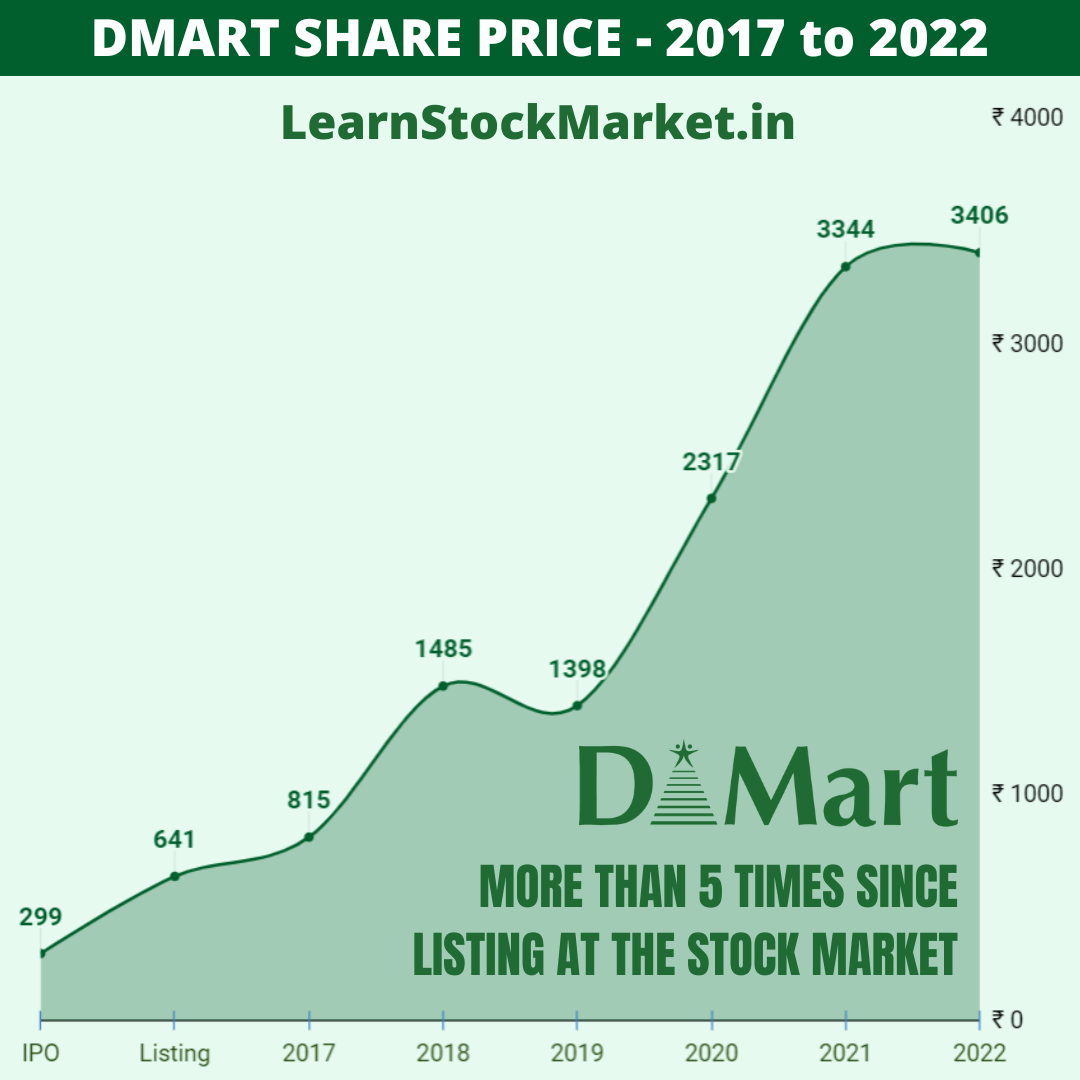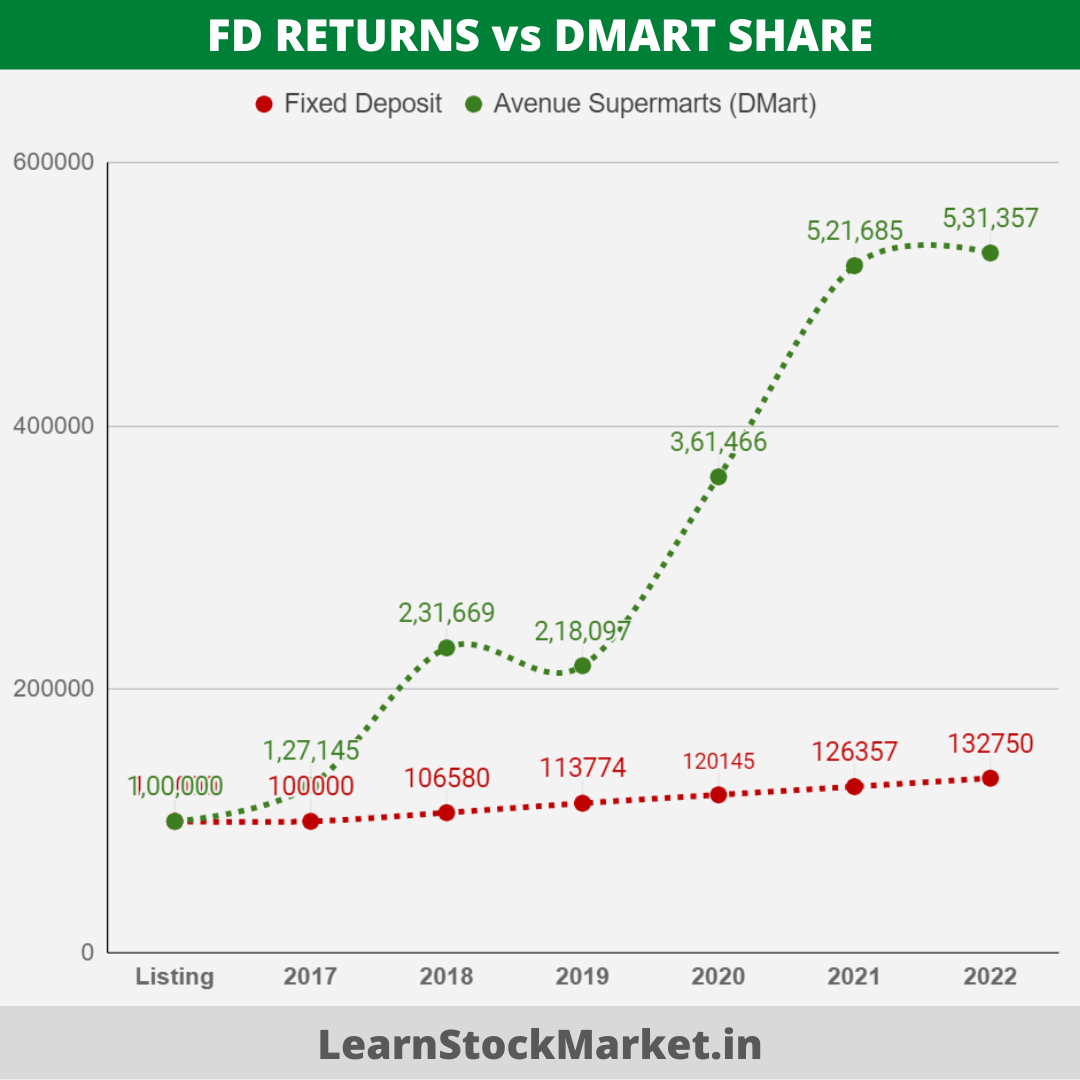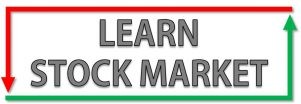The DMart Share Price has gone up 11 times in the last 5 years. If you had got allotment of shares worth 1 lakh in the IPO, its value today would be 11 lakhs.
Even a single lot of 15,000 rupees in the IPO, would be worth 1.65 lakhs today.
That is the potential power of investing in top-quality companies like DMart – and more so because the founder, Mr Radhakishan Damani, who is an investor himself, wasn’t greedy during the IPO. He left value for investors, unlike most IPOs in recent times.
If you learn how to pick the right companies, have patience, and can handle the volatility (up and down movement of stock price), investing in the stock market can make you extremely wealthy.
Before we get into deeper analysis, let us check out the short 5-year stock price history of Dmart.
Note: The analysis on this page is based on the closing price of Dmart on June 30 2022 – which is the end of the first half of the year.
DMart Share Price
The below image has the June-end share price of Dmart (Avenue Supermarts) from the year 2017 when it was listed at the stock marker to June 2022.
The ₹ 2317 price mentioned is at the end of June 2020. ₹ 3344 was the share price at the end of June 2021 and so on.

| DMart | Share Price | Rise / Fall |
| IPO Share Price | 299 | |
| Listing Share Price | 641 | 114.38% |
| 2017 Share Price | 815 | 27.15% |
| 2018 Share Price | 1485 | 82.21% |
| 2019 Share Price | 1398 | -5.86% |
| 2020 Share Price | 2317 | 65.74% |
| 2021 Share Price | 3344 | 44.32% |
| 2022 Share Price | 3406 | 1.85% |
Did you notice a pattern in the 5-plus years since the listing of Dmart? The stock price has gone up significantly for 2 years, followed by one year of negative returns.
Then again, the price went up for 2 years in 2020-21 and has given no returns in the 2021-22 period.
Does it mean 2023-24 will be good for the stock? Not really. You cannot buy based on such price patterns, because if business growth stagnates for the next few years – the stock price could stagnate or even fall further.
If the border market remains weak, the stock might not rise.
Stock price movement in the upward direction is usually a combination of future earnings growth potential of a company along with positive market sentiments.
At the time of writing this article, the Dmart share price has crashed more than 40% from its all-time-high of 5900 per share on 18th October 2021.
Just because the stock price has fallen, does not automatically make it a screaming buy. The valuations are still very high. The price-to-earning (P.E) is still above 150, which puts it firmly in the ‘extremely expensive’ category.
The price could fall further or consolidate in a range for several months or even years.
What’s interesting is the share price of Dmart has never fallen this much from the time it has been listed at the stock exchanges.
When global markets crashed in 2020 due to the outbreak of Covid, Dmart was one of those stocks that fell less. It crashed by 30% in Feb-March 2020, compared to the 40% fall between October 2021 to June 2022.
Dmart Share Returns
How much returns has Dmart given in the last 1 to 5 years? What if you bought it on the day it was listed on the stock market?
What if you were one of the lucky few to have grabbed a few shares in the IPO and held it through its ups and downs?
Check out the table below:
| CAGR | Absolute | |
| 1 year | 1.85% | 1.02 times |
| 2 years | 21.24% | 1.47 times |
| 3 years | 34.56% | 2.44 times |
| 4 years | 23.06% | 2.29 times |
| 5 years | 33.11% | 4.18 times |
| Since Listing | 39.66% | 5.31 times |
| Since IPO | 62.67% | 11.39 times |
If you bought the IPO and still hold the shares today, the returns are beyond extraordinary. The company has given 62% CAGR – even after the recent 40% fall.
At its all-time-high price of 5900 in October 2021, the returns from IPO price was a mind-numbing 110% CAGR.
The listing price was no less spectacular. Dmart listed at ₹ 641 which was 115% gains on the listing day itself.
It looked like it was a steep price to pay, but those who had the conviction to buy on the listing day, have made ‘market beating returns’ of nearly 40% CAGR. The stock is up more than 5 times from ₹ 641 – at the time of writing this article.
1 lakh invested in Dmart
| 1 Lakh Invested | Would Be |
| At IPO Price | 11,39,130 |
| At Listing Price | 5,31,357 |
| 5 years ago | 4,17,914 |
| 4 years ago | 2,29,360 |
| 3 years ago | 2,43,634 |
| 2 years ago | 1,47,000 |
| 1 year ago | 1,01,854 |
If you invested 1 lakh at IPO price, the value of your investment would be more than 11 lakhs on June 30 2022 – 5 years and a few months after the Dmart IPO.
If you invested on the day the stock was listed on NSE / BSE – the value would be more than 5 lakhs today.
These are staggering numbers, but they only look great with the benefit of hindsight.
Let us say, you were lucky to get allotment worth 1 lakh from the IPO. On the listing day itself, the value would be more than 2 lakhs. You would immediately have the urge to sell and book your profits.
“What if the stock falls?”
“What if the market crashes?”
At every stage, an investor battles the urge to sell before the market crashes and the profits go away.
This is the reason why a lot of people earn money in the market, but very few are able to create long-term wealth.
If you sold it on the day it listed, it would be very difficult to buy it back at a higher price.
But if you decide never to sell, the stock can crash from 5900 to 3400 – like it has in the last 1 years, taking away huge gains.
Valuation-wise, you cannot take a decision – because stocks like Dmart have always been expensive. It has always been above 100 PE for the most part.
A value-investor would never even think of buying it, yet the stock has given extraordinary returns.
The solution? Chart analysis. Learning price action can help you get the “selling decision” right. It will never be perfect. You can never sell at the top or buy at the bottom. But you can sell before a large breakdown – or on the first few signs of a long-term breakdown.
It can also help you buy in the right areas. Go through the articles on our website, there is a lot of info here.
Dmart vs FD Returns
What if you opened a fixed deposit of ₹ 1 lakh in a bank and made another investment of 1 lakh in Dmart Shares. For the sake of comparison, let us assume both investments were made as soon as Dmart was listed at the stock market (i.e. 5 years ago).
| Fixed Deposit | DMart | |
| Listing | 100000 | 1,00,000 |
| 2017 | – | 1,27,145 |
| 2018 | 106580 | 2,31,669 |
| 2019 | 113774 | 2,18,097 |
| 2020 | 120145 | 3,61,466 |
| 2021 | 126357 | 5,21,685 |
| 2022 | 132750 | 5,31,357 |
| Returns | 5.83% | 39.66% |
Note: FD interest rates have been adjusted each year, as per data taken from Reserve Bank of India (RBI). The average FD rate over last 10 years has been around 7%. The interest rates are lower at the time of writing this article in 2022, but it was higher in 2011.
The numbers say it all. If you bought Dmart shares worth 1 lakh on the day it was listed, the shares would be worth 5.31 lakhs today.
However, if you kept the same amount in a Fixed deposit, it would be 1.32 lakhs. The difference is huge.
Again, if you learn to handle volatility, buying good companies at the right time (usually when the market falls) should give you FD-beating returns in the long run.

Some points:
- Why does an FD investment feel good even if it does not give good returns? The answer is simple. There is no uncertainty. An FD cannot fall in value.
- On the other hand, stock prices are completely unpredictable. If there is a war between two major countries, or if there is an outbreak of a deadly virus – stock markets can suddenly fall 50% within a few days.
- Even when Dmart has continued to grow and deliver excellent quarterly results, the stock price has fallen 40% recently due to Russia-Ukraine war and fear of global recession.
- This is what makes stock investing a journey full of ups and downs, whereas an FD will continue to go up in a straight line.
- There is peace of mind in one, while the other can give you sleepless nights when it is going down and make you incredibly happy when it is rising.
- It is easy to look back and wish you had invested in Dmart early-on when the price was in 3-digits. But stocks that are rising quickly, are very difficult to buy.
- Think about it. The IPO was over-subscribed, so getting even 1-lot of shares (valued at ₹ 15,000) was difficult.
- What if you recognized the future potential of the company and decided to buy it on the day it was listed? Again, it would be very difficult to buy.
- The IPO price was ₹ 299 and on the day it was available to purchase from the stock exchanges – the price was already above ₹ 600. It is extremely difficult to buy when a stock has doubled on the listing day itself. What if it falls and gives a better opportunity to buy? You decide to wait for a better price.
- But guess what? That better price never comes. The stock has never gone below ₹ 600 after its listing day. And within 3 weeks of listing, the share price had already crossed ₹ 750.
- Once the price reaches ₹ 750, you regret thinking you should have bought it at ₹ 600. But when the price was at ₹ 600, it looked too expensive to buy. These decisions are difficult to make.
- Dmart did give a few opportunities in between when the broader market corrected – but the valuation was always very expensive.
- It is only now, with the stock falling 43% from the peak – Dmart (listed as Avenue Supermarts) has given an opportunity to buy. Even at this point, there are doubts. The valuation is still high. Can the stock fall more? What if it consolidates in a range for the next 3-4 years, allowing the earnings to catch up with the high price of the stock.
- This happens quite often in quality companies. They can undergo ‘time correction’ for extended periods – sometimes stretching for several years. There are several examples of this, but let us take a well-known company.
- Britannia (the biscuit company) was in a strong uptrend for 5 years between 2013 to 2018. However, between 2018 to 2022 the stock has given little or no returns. It has remained range-bound with the price neither falling a lot, nor rising.
- During this period, the net profit of the company went up 2-3 times. But the stock price hasn’t moved.
- This can happen with a company like Dmart too. It can remain range bound for several years, during which time the business could continue to grow but the stock price may not move. If this does happen after you decide to buy the stock at the current price – it could lead to years of frustration where you see other stocks moving, but Dmart remaining stagnant.
- After several years of holding the company, when an investor eventually loses patience and decides to sell – the stock price could, then, suddenly move up 2x making you feel like a fool for selling it just before the rise.
- This is what makes investing extremely difficult. It is a game of patience. Stock prices will never move in line with quarterly earnings of a company. You could have a company declaring outstanding results, but the next day the stock price could crash 10%.
- At the same time, a company could declare poor results and the stock could rise 10%.
- The markets will surprise on both sides. The unexpected will happen. If only the expected were to happen, everyone would make money.
- Investing is challenging, which is the reason why very few are able to make a lot of money. It requires time, effort and market experience.
That is it for this article on the Dmart Share Price. If you have any questions, feel free to ask in the comments section below.


This is fantastic analysis. Keep up the good work.
If you can share similar 20 25 year cage shareholder returns analysis of consistent compounders like Honeywell automation , berger paints, p i industries , Havells, relaxo etc it will very helpful to your users